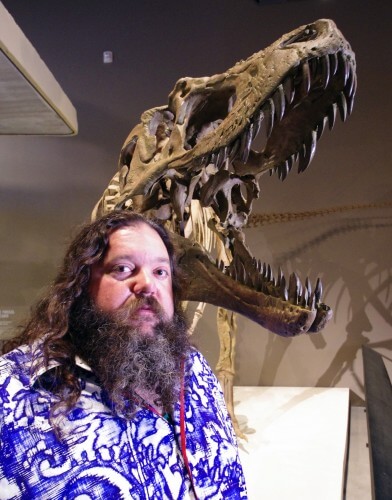Lythronax argestes has unique features: a narrow snout while the back part of the skull was wide and the eyes were placed in the front part so that it allowed binocular vision, as in its later relative - Tyrannosaurus Rex

An amazing new species of tyrannosaurus was discovered at the Grand Staircase-Escalante site in southern Utah. The giant carnivore lived on the Laramidian continent on the west coast of a shallow sea that flooded the central area of North America and isolated the western part from the eastern part of the continent 70-95 million years ago during the Cretaceous period.
The report on the newly discovered dinosaur, which belongs to the same evolutionary branch as the famous Tyrannosaurus rex, was published this week in the open-access scientific journal PLoS ONE as well as in an exhibit in the Past Worlds Gallery at the Utah Museum of Natural History at the Rio Tinto Center in Salt Lake City.
Among the tyrannosaurs was a small group of predatory dinosaurs standing on two legs, ranging from medium size to gigantic creatures including Tyrannosaurus rex that lived during the Jurassic and Cretaceous periods. The newly discovered dinosaur, Lythronax argestes, has unique features: a narrow snout while the back of the skull was wide and the eyes were placed in the front.
The term Lythronax can be translated as "King of the Killing Machines" and the second part of the name, argestes refers to the geographical location of the Southwest USA. Previously, paleontologists believed that this type of broad-skulled tyrannosauroid appeared only 70 million years ago, while Lithronax appeared at least ten million years earlier.
Lythronax lived in Larmedia, along the western shores of the Seaway that divided North America. This land mass contained unique dinosaur species and served as a melting pot of iconic dinosaur groups such as the horned and the duck-shaped. This study also showed that tyrannosauroid dinosaurs (the group that includes T. rex) likely evolved in isolation on an island continent. Lithronax stands out in this group in that it had a much wider skull in the eye area and a narrow snout, similar to that of its relative T. rex, which lived 10-12 million years later. Dr. Mark Levin, principal investigator from the Utah Museum of Natural History and the Department of Geology and Geophysics at the University of Utah says: "The width of the back of Lithronax's skull allowed it to see overlapping fields of vision, which gave it binocular vision, a useful trait for a predator and one we associate with T .Rex.”
Paleontologists have recently determined that the dinosaurs of southern Laramidia (Utah, New Mexico, Texas, and Mexico), despite belonging to the same main groups, are different from the species of northern Laramidia (Montana, Wyoming, Dakota, and Canada). The tyrannosauroid relatives of southern Laramide are more closely related to each other than to the long-snouted ones of northern Laramide.

Prof. Aryeh Warshel gave a comprehensive interview to the Hidan site
Dr. Joseph Sertich, co-researcher, said: "Lythronax may illustrate that the tyrannosaurs followed the same pattern we saw in other dinosaurs from the same period - which discovered differences between species living in the south and north at the same time. This pattern of dinosaur distribution across Laramidia leads researchers to ask what might have caused the north-south divide, given that large dinosaurs could walk from Alaska to Mexico, given enough time. Dr. Randall Irmis, another member of the team explains that by analyzing the evolutionary relationships, geological age and geographic distribution of the tyrannosauroids, the team members determined that Lythronax and the other tyrannosauroids split 80-95 million years ago during the period when this inland sea existed at its maximum size. The invasion of the sea into large parts of low-lying areas in Laramide could have separated small pieces of land from each other and allowed different species of dinosaurs to develop in isolation from each other, in different parts of the continent. "When the sea receded 80 million years ago, these differences in dinosaur species were preserved due to climatic variation, differences in food sources (prey and plants) and other factors. This hypothesis explains why the iconic dinosaurs of western North America are so different from those that lived on other continents at the same time.

5 תגובות
At last! Something clear I can unsnddtaer. Thanks!
Reconstructions (Why can't you write here in a normal way through the iPhone? This is a site that is compatible with 2013? Really annoying)
Quite disappointing, really (until recently when I saw these pictures from museums I was sure I was looking at the real skeleton, really disappointing to hear that these are only
Tell me, aren't these reconstructions a type of "eye work"? A person goes to a museum and sees in front of him a complete skeleton of a dinosaur, when in fact barely 30% of the bones were found, and the rest will come back as the good imagination of the scientist who built the skeleton.